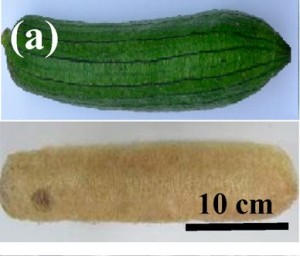Chuyển sang chế độ ngoại tuyến với ứng dụng Player FM !
Episode 7 – The Battery Outbreak
Manage episode 56677734 series 30865

Loofah Image from Chi Paper
This week on LASER, Emily and Cameron discuss batteries built by modified viruses, charge-dependent crystal changes of Lithium/Selenium-Sulfer Batteries, and Microbiological fuel cells built on natural loofah sponges.
1:15 we start on “Better Batteries Through Biology?” (HERE is the full paper)
13:00 the three major metrics for battery performance
15:00 will these battery-building viruses cause the next zombie outbreak? hint: probably not.
20:25 we start on the second story: “(De)Lithiation Mechanism of Li/SeSx (x = 0–7) Batteries Determined by in Situ Synchrotron X-ray Diffraction and X-ray Absorption Spectroscopy”
27:30 they realized that SeS7 electrodes have the highest charge capacity after 50 cycles, which is a hybrid of the Li-Se and Li-S electrodes.
30:00 the three areas of research that are being worked on to improve battery technologies
3X:XX After a sad attempt at a transition, our third and final story today is based on the paper: “Nanostructured Macroporous Bioanode Based on Polyaniline-Modified Natural Loofah Sponge for High-Performance Microbial Fuel Cells”
35:54 correction: the bacteria don’t “Create” electrons, they just take them off of the food when they’re eating, and they don’t need it.
44:37 For these microbial fuel cells they report a power density of 1090 mW/m^2 (or 1.09 Watts/m^2). For comparision a solar panel is about 170 W/m^2, but solar is the highest power density of the renewable energy technologies, vs 0.22W/m^2 for corn ethanol and 1000W/m^2 for fossil fuels, source home.cc.umanitoba.ca/~vsmil/pdf_pubs/oecd.pdf .
47:00 these icrobial fuel cells would not be for high current high power applications, like cars. They would be useful for slowly generating a constant stream of power to be stored in something like a battery.
52:20 we start the signoff for an unusually-short (but targeted length) episode of LASER!
Emily picked the bumper music for this week, so there’s:
Intro: Open – Crying (Get Olde)
Beyond Electric Dreams – Bad Religion
Electricity – NOFX
Outro: Dreams are Maps – The Wild (Dreams are Maps)
26 tập
Manage episode 56677734 series 30865

Loofah Image from Chi Paper
This week on LASER, Emily and Cameron discuss batteries built by modified viruses, charge-dependent crystal changes of Lithium/Selenium-Sulfer Batteries, and Microbiological fuel cells built on natural loofah sponges.
1:15 we start on “Better Batteries Through Biology?” (HERE is the full paper)
13:00 the three major metrics for battery performance
15:00 will these battery-building viruses cause the next zombie outbreak? hint: probably not.
20:25 we start on the second story: “(De)Lithiation Mechanism of Li/SeSx (x = 0–7) Batteries Determined by in Situ Synchrotron X-ray Diffraction and X-ray Absorption Spectroscopy”
27:30 they realized that SeS7 electrodes have the highest charge capacity after 50 cycles, which is a hybrid of the Li-Se and Li-S electrodes.
30:00 the three areas of research that are being worked on to improve battery technologies
3X:XX After a sad attempt at a transition, our third and final story today is based on the paper: “Nanostructured Macroporous Bioanode Based on Polyaniline-Modified Natural Loofah Sponge for High-Performance Microbial Fuel Cells”
35:54 correction: the bacteria don’t “Create” electrons, they just take them off of the food when they’re eating, and they don’t need it.
44:37 For these microbial fuel cells they report a power density of 1090 mW/m^2 (or 1.09 Watts/m^2). For comparision a solar panel is about 170 W/m^2, but solar is the highest power density of the renewable energy technologies, vs 0.22W/m^2 for corn ethanol and 1000W/m^2 for fossil fuels, source home.cc.umanitoba.ca/~vsmil/pdf_pubs/oecd.pdf .
47:00 these icrobial fuel cells would not be for high current high power applications, like cars. They would be useful for slowly generating a constant stream of power to be stored in something like a battery.
52:20 we start the signoff for an unusually-short (but targeted length) episode of LASER!
Emily picked the bumper music for this week, so there’s:
Intro: Open – Crying (Get Olde)
Beyond Electric Dreams – Bad Religion
Electricity – NOFX
Outro: Dreams are Maps – The Wild (Dreams are Maps)
26 tập
Όλα τα επεισόδια
×Chào mừng bạn đến với Player FM!
Player FM đang quét trang web để tìm các podcast chất lượng cao cho bạn thưởng thức ngay bây giờ. Đây là ứng dụng podcast tốt nhất và hoạt động trên Android, iPhone và web. Đăng ký để đồng bộ các theo dõi trên tất cả thiết bị.




